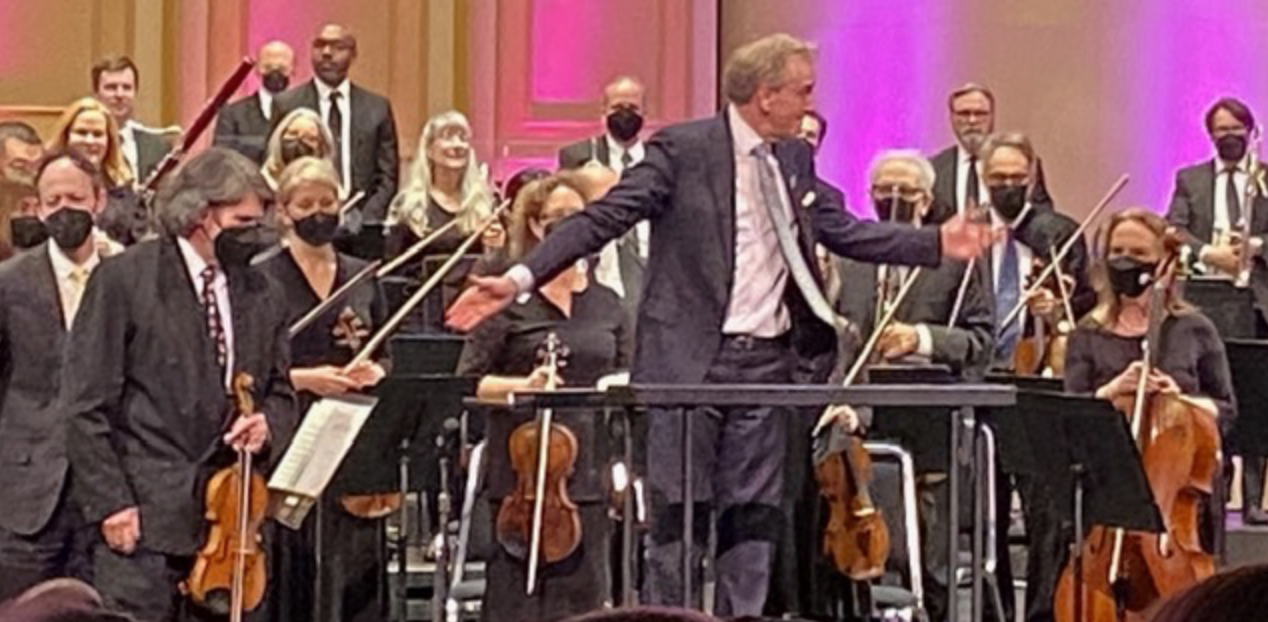|
Symphony
FROM THE NEW WORLD TO THE OLD WORLD
by Peter Lert
Saturday, June 14, 2025
Chamber
MC2 DUO RECITAL CLOSES 222'S SEASON
by Terry McNeill
Saturday, June 14, 2025
Choral and Vocal
CANTIAMO SONOMA'S LUSCIOUS A CAPELLA SINGING IN SEASON ENDING CONCERT
by Pamela Hicks Gailey
Sunday, June 8, 2025
Symphony
SRS SEASON ENDS WITH RESOUNDING TA-TA-TA-BANG
by Terry McNeill
Sunday, June 1, 2025
Symphony
YOUTHFUL VIRTUOSITY ON DISPLAY AT USO'S MAY CONCERTS
by Peter Lert
Saturday, May 17, 2025
Symphony
MYSTICAL PLANETS AND LIVELY GERSHWIN ORTIZ AT FINAL SRS CONCERT
by Peter Lert
Sunday, May 4, 2025
Symphony
VSO'S CONCERT MUSIC OF TIME, MUSIC OF PLACE
by Peter Lert
Sunday, April 27, 2025
VOCAL ELEGANCE AND FIRE AT THE 222'S RECITAL APRIL 26
by Pamela Hicks Gailey
Saturday, April 26, 2025
CANTIAMO SONOMA SINGS AN INSPIRED GOOD FRIDAY MOZART REQUIEM CONCERT
by Pamela Hicks Gailey
Friday, April 18, 2025
DRAMATIC SHOSTAKOVICH SYMPHONY CLOSES PHILHARMONIC'S 25TH SEASON
by Terry McNeill
Sunday, April 13, 2025
|
 |
 Ovation for Alasdair Neale at Marin SO March 6 |
KALEIDOSCOPIC SAINT-SAENS AT MARIN SYMPHONY
by Abby Wasserman
Sunday, March 6, 2022
Before launching into the long-delayed, long-anticipated Masterworks III Marin Symphony program March 6, Conductor Alasdair Neale announced that in solidarity, the orchestra would play the Ukrainian National Anthem. Without being prompted to do so, the audience of 1200 sprang to its feet. National anthems are designed to stir the blood, and the Ukrainian anthem, in the context of the second tragic week of the Russian war on that nation, did just that.
Then came the maelstrom of immersive sound that is Anna Clyne’s 2013 tone poem Masquerade. Cue the wind: swelling strings, clacking percussion, mournful flutes, shining brass—every way that wind can be evoked musically was evoked: breezes, gusts, dust devils, wind tunnels, tornados whirling with flying jetsam a là Wizard of Oz.
A few times when the wind calmed, snatches of a Scottish dance or an English folk tune introduced a melody which, however, was quickly extinguished by more wind. The snappy beats of the snare drum and the shivering strings shot by like racing clouds. It was nature in turmoil. Ms. Clyne regrettably did not develop her brief melodic motifs, and after the final flourish of cymbals one felt positively wind-blown. If the Ukrainian National Anthem hadn’t already quickened the collective heartbeat, Masquerade did the job.
Vadim Gluzman was the announced soloist for the Beethoven D Major Violin Concerto, Op. 61, but was unable to travel due to “pandemic-related travel complications.” Los Angeles-based violinist Simone Porter gallantly stepped in at the last minute, and performing from the score, she displayed impressive confidence in the majestic opening movement. Her high notes were beautifully pure and she played the concerto’s many long, sustained trills to perfection. However, the volume of her instrument was too soft to compete with the massive sound of the 76-member symphony orchestra, and time and again the Symphony’s powerful sonority swallowed the violin’s voice. This imbalance was unfortunate, because when the orchestra and the violin don’t mesh, a concerto can sound like unglued layers.
Mr. Neale’s tempo was brisk in the first movement and really didn’t allow for many liberties from the soloist, but the transparent second movement allowed too many liberties: it threatened to drag, though there were many moments of warm beauty.
The concerto from 1806 is chock full of repetitive phrases, both in its orchestral parts and solo violin passages, and each repeat has the potential for variation. The violinist has a great deal of latitude to provide varied emotional and sonic coloration from one phrase to its repeat, and Beethoven’s palette is rich in this work, so there’s great opportunity to mix in tints and shades. Ms. Porter didn’t do much of this here. She repeated phrases nearly identically as in the first statements, and as a result, her reading lacked a certain emotional depth. However, when Mr. Neale stopped the Orchestra, she played the Kreisler cadenza with a clarion sound, although in several rapid passages the runs were blurred and lacked clarity. Double stop technique was admirable.
For the Orchestra, horn and woodwind playing were especially eloquent, and the conductor fashioned a passionate performance of a regal score. At the end Ms. Porter received a standing ovation, and shouts of “Bravo!” echoed around the hall.
After a short intermission the audience returned, eyeing the two colossal loudspeakers on either side of the stage and the organ that was brought in for the culminating work on the program, the Saint-Saëns’ Organ Symphony, the Op. 78 in C Minor. The organist, Christopher Keady, sat next to Marin Symphony’s pianist, John Wilson, down stage right, and just seeing them there quickened the pulse. It’s a challenge to get one’s arms around this monumental work, divided into two complicated parts: Adagio-Allegro moderato-Poco adagio and Allegro moderato-Presto-Maestoso-Allegro. From 1885, the composer’s Third Symphony is a kaleidoscopic tour-de-force.
String and brass playing evoked a gathering of migratory birds on a shining lake at dawn: calling, honking, quacking, whistling, cooing, fluttering, splashing. The first movement is a live world of layered sound, all in restless and constant movement, all reaching towards the sublime as the sun warms their wings. Exquisite melodies abound with the first hymn-like introduction of the organ. And then a fugue theme begins, making a shimmering pavane of now dramatic, now angelic, sonority.
The playing of the second movement began urgently, frenetically, signaling that something ominous or great was about to happen, and soon the rich organ line met the violins, violas and oboes sounding a musical awakening. There were rolling piano arpeggios, dramatic organ and strings motives, and clashes of cymbals.
Mr. Neale kept his orchestra under careful control, no small feat with such surging and compelling music. An expected standing ovation ensued, with three curtain calls for the conductor and recognition for individual players.
Richard Mani and Terry McNeill contributed to this review
|

